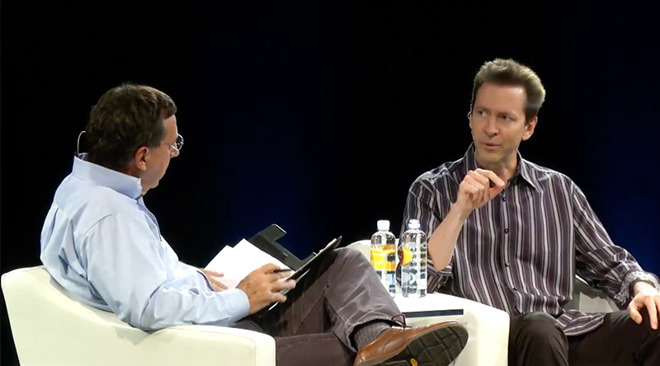In his first public interview since leaving Apple in 2012, former head of iOS development Scott Forstall provided commentary on his background, the first iPhone and his relationship with company cofounder Steve Jobs.

Speaking with John Markoff, formerly of the New York Times, Forstall offered a timeline of events leading up to his contribution to "Project Purple," the secret internal initiative that ultimately resulted in the first iPhone.
Forstall took a shine to computing after experimenting with his brother's TRS-80. His coding prowess landed him a job developing programs the U.S. Navy used to test the structural integrity of aircraft carriers. In high school, Forstall graduated to developing parts of weapons systems used in submarines carrying Trident Ballistic Missiles.
From there, Forstall went on to study computer related fields with a concentration in artificial intelligence at Stanford University. It was after obtaining his master's degree that he had to make the choice between working at Microsoft, where he had interned during college, and NeXT.
Through a series of unmentioned events, Jobs himself ended up interviewing Forstall in 1992. The two found common ground on a number of topics and Forstall ultimately opted to work at NeXT despite the company's shaky financial standing.
Apple purchased NeXT in 1997, bringing Jobs, Forstall and a slew of talented engineers on board.
"At some point Steve decided Apple needed us," Forstall said of NeXT.
It was when Forstall was working on Mac OS X running releases that Project Purple was born.
According to the former executive, it was Jobs' hatred of a particular Microsoft executive that sparked his interest in tablet computing. Jobs' wife Laurene had a friend whose husband worked for Microsoft, Forstall said. This unnamed executive apparently rubbed Jobs the wrong way on multiple occasions, but it was one meeting in particular that set the tech guru off.
Microsoft was developing a tablet platform based on stylus interactions that was cutting edge for the time. The unnamed executive "shoved it in Steve's face" that the technology would "rule the world." Pooh-poohing the notion of a stylus first user interface, Jobs decided to challenge Microsoft with Apple's own solution.
Dubbed Project Purple, the idea was to create a computing system that involved human touch without relying on extraneous hardware. In particular, engineers were developing a multitouch user interface based on interactions with capacitive touch sensing screens.
It was around this time that Apple was morphing from a computer company to an electronics company.
"Half our sales were iPods, so we were turning into a consumer electronics company," Forstall said. Apple was looking toward the horizon at new technologies that had the potential of disrupting iPod and the broader digital music market. Phones, or more specifically smartphones, seemed to be a prime contender.
Forstall recalled how he and Jobs were sitting at lunch one day with their phones. They both hated the clunky interfaces offered by market leaders like Blackberry, Forstall said, and looking at nearby tables so did the people around them. Jobs asked if Forstall and his team could make a multitouch demo on hardware small enough to fit in a pocket. And so came the first visions of iPhone.
The former Apple exec went on to detail meetings with key industry contacts, including the first iPhone demo for Cingular Wireless CEO Stan Sigman.
On a more personal note, Forstall revealed Jobs saved his life in the early 2000s. Around 2004, Forstall contracted a stomach virus from his children. The ailment turned into a much more serious condition that had Forstall constantly vomiting. Over the course of two months, the executive lost some 60 pounds and was hospitalized, with medical staff forced to feed him through a tube.
During the ordeal Jobs would call on a daily basis, checking in and offering non-traditional health advice.
"And one night at about 10 o'clock at night -- this is now months into it -- Steve calls and says, 'I have the best acupuncturist in the world and I'm going to bring her to you tonight and she's going to fix you," Forstall said.
The unconventional treatment worked.
Forstall's commentary was the closing act in a two-part interview at the Computer History Museum in Mountain View, Calif. Before Forstall took the stage, three former Apple engineers -- Hugo Fiennes, Nitin Ganatra and Scott Herz -- talked with Markoff about their contribution to iPhone. The entire two-hour chat can be viewed below.
Forstall ended the evening by thanking everyone in the audience who had participated in creating iPhone, iPad and iOS.
"It's not one person, or even four people," Forstall said. "It was hundreds and thousands of people who made it happen."


